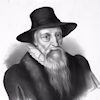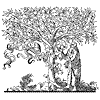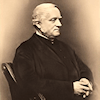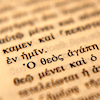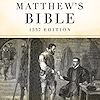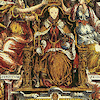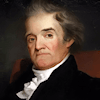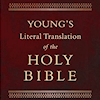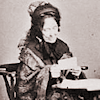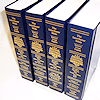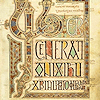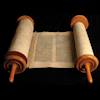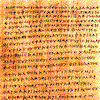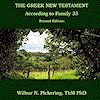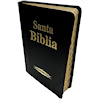Textus Receptus Bibles
Textus Receptus Bibles Historical Information
Textus Receptus (Scrivener 1894)
In the latter part of the 19th century, F. H. A. Scrivener produced an edition of the Greek New Testament which reflects the Textus Receptus underlying the English Authorised Version.
F. H. A. Scrivener (1813-1891) attempted to reproduce as exactly as possible the Greek text which underlies the Authorised Version of 1611. However, the AV was not translated from any one printed edition of the Greek text. The AV translators relied heavily upon the work of William Tyndale and other editions of the English Bible. Thus there were places in which it is unclear what the Greek basis of the New Testament was. Scrivener in his reconstructed and edited text used as his starting point the Beza edition of 1598, identifying the places where the English text had different readings from the Greek. He examined eighteen editions of the Textus Receptus to find the correct Greek rendering, and made the changes to his Greek text. When he finished he had produced an edition of the Greek New Testament which more closely underlies the text of the AV than any one edition of the Textus Receptus.
Textus Receptus (Elzevir 1624)
1624 Elzevir Textus Receptus, edited by Abraham and Bonaventure Elzevir. Transcription by Maurice Robinson.
The Elzevir's published three editions of the Greek New Testament. The dates being; 1624, 1633 and 1641. The Elzevir text is practically a reprint of the text of Beza 1565 with about fifty minor differences in all. The Elzevirs were notable printers, and their editions of the Greek New Testament were accurate and elegant. They were of Flemish ancestry and were famous printers for several generations. Throughout Europe the Elzevir editions came to occupy a place of honor, and their text was employed as the standard for commentary and collation. The text of this 1633 edition became known as the "Textus Receptus" because of an advertisement in Heinsius' preface that said in Latin Textum ergo habes, nunc ab omnibus receptum: in quo nihil immutatum aut corruptum damus, 'Therefore you have the text now received by all in which we give nothing altered or corrupt.'
Textus Receptus (Beza 1598)
Theodore Beza, Novum Testamentum. 4th folio edition. Geneva, 1598.
The basis of Beza's text was the Stephanus 1551 edition (which adds verse numbering to his 1550 edition), which in turn was substantially that of Erasmus' later editions. Beza made only a few minor changes to the Stephanus text, amounting to less than a hundred. Over a dozen of these changes where to the Bible book titles and did not affect the body of the text. Further to this, many of his changes where to diacritical accent markings which had little or no affect on any subsequent translation to English.
Beza was a prominent theologian and scholar in Geneva, and his changes were generally taken to be improvements upon the text. Despite his qualifications, he seems not to have applied himself to the improvement of the Stephanus text but his annotations to the text where of interest to later scholars. His 1598 text was the one most often followed by the translators of the King James version, and it also became the basis of the later Elzevir editions of 1624, which on the continent held a place comparable to the Stephanus editions in England.
Textus Receptus (Stephanus 1550)
Robert Estienne (known as Stephanus) (1503-1559) edited and printed four editions of the Textus Receptus from 1546 to 1551. His third edition of 1550 was the first to have a critical apparatus, with references to the Complutensian Polyglot and fifteen additional Greek manuscripts. The fourth edition of 1551 had the same Greek text as the third, but is especially noteworthy for its division of the NT books into chapters and verses, a system still in use today.
Masoretic Text 1524
The Hebrew text of the Old Testament is called the Masoretic Text because in its present form it is based upon the Masora—the Hebrew, textual tradition of the Jewish scholars known as the Masoretes (or Masorites). The Masoretes were rabbis who made it their special work to correct the faults that had crept into the text of the Old Testament during the Babylonian captivity, and to prevent, for the future, its being corrupted by any alteration. They first separated the apocryphal from the canonical books, and divided the latter into twenty-two books, being the number of letters in the Hebrew alphabet. Then they divided each book into sections and verses.
There is a great difference of opinion as to when the Masoretic Text was written, but it was probably accomplished in the 10th -11th century. Several editions existed, varying considerably, but the received and authoritative text is that of Jacob ben-chayim ibn Adonijah, who carefully sifted and arranged the previous works on the subject. It was published in 1524.
King James Bible 2016
Unlike most other modern versions, this Bible's text is based upon the same Hebrew Masoretic Text, and Greek Textus Receptus, of the King James Version of 1611.
In non Textus Receptus versions, the issue of having the best underlying manuscripts, is often overshadowed by the massive amount of omissions in the text. Because the KJV 2016 is not dealing with issues of omission and addition, the focus has been upon definition, and the KJV translators choices have been used as the benchmark.
One issue not often majored upon in the bible version debate is simply the way Greek words are defined. Many times, the NKJV leans upon the definition choices of modern versions as well as defaulting to Vines and Strong's definitions, which are almost always favorable to the Revised Version. In other words, one may have a correct text to translate from, but use erroneous modern version/modern dictionary definitions which change or distort the meaning of the words. Jay Green was accused of having a good TR bible but with "Alexandrian readings".
The KJV 2016 Edition rejects such erroneous modern definitions and restores the distinctness of historical KJV readings. The NKJV also tended to gravitate toward KJV marginal notes, which are in truth, rejected readings, and also toward Geneva Bible definitions, which the KJV had already cleared up.
The King James Version 2016 Edition is copyright 2016, only to protect it from being stolen and resold for profit. All Rights reserved. Further details
King James Bible 1769
By the mid-18th century the wide variation in the various modernized printed texts of the Authorized Version, combined with the notorious accumulation of misprints, had reached the proportion of a scandal, and the Universities of Oxford and Cambridge both sought to produce an updated standard text. First of the two was the Cambridge edition of 1760, the culmination of twenty-years work by Francis Sawyer Parris, who died in May of that year. This 1760 edition was reprinted without change in 1762 and in John Baskerville's fine folio edition of 1763. This was effectively superseded by the 1769 Oxford edition, edited by Benjamin Blayney.
King James Bible 1611
The commissioning of the King James Bible took place at conference at the Hampton Court Palace in London England in 1604. When King James came to the throne he wanted unity and stability in the church and state, but was well aware that the diversity of his constituents had to be considered. There were the Papists who longed for the English church to return to the Roman Catholic fold and the Latin Vulgate. There were Puritans, loyal to the crown but wanting even more distance from Rome. The Puritans used the Geneva Bible which contained footnotes that the king regarded as seditious. The Traditionalists made up of Bishops of the Anglican Church wanted to retain the Bishops Bible.
The king commissioned a new English translation to be made by over fifty scholars representing the Puritans and Traditionalists. They took into consideration: the Tyndale New Testament, the Matthews Bible, the Great Bible and the Geneva Bible. The great revision of the Bible had begun. From 1605 to 1606 the scholars engaged in private research. From 1607 to 1609 the work was assembled. In 1610 the work went to press, and in 1611 the first of the huge (16 inch tall) pulpit folios known today as "The 1611 King James Bible" came off the printing press.
Green's Literal Translation 1993
Green's Literal Translation (Literal Translation of the Holy Bible - LITV), is a translation of the Bible by Jay P. Green, Sr., first published in 1985. The LITV takes a literal, formal equivalence approach to translation. The Masoretic Text is used as the Hebrew basis for the Old Testament, and the Textus Receptus is used as the Greek basis for the New Testament.
Julia E. Smith Translation 1876
The Julia Evelina Smith Parker Translation is considered the first complete translation of the Bible into English by a woman. The Bible was titled The Holy Bible: Containing the Old and New Testaments; Translated Literally from the Original Tongues, and was published in 1876.
Julia Smith, of Glastonbury, Connecticut had a working knowledge of Latin, Greek and Hebrew. Her father had been a Congregationalist minister before he became a lawyer. Having read the Bible in its original languages, she set about creating her own translation, which she completed in 1855, after a number of drafts. The work is a strictly literal rendering, always translating a Greek or Hebrew word with the same word wherever possible. Smith accomplished this work on her own in the span of eight years (1847 to 1855). She had sought out no help in the venture, even writing, "I do not see that anybody can know more about it than I do." Smith's insistence on complete literalness, plus an effort to translate each original word with the same English word, combined with an odd notion of Hebrew tenses (often translating the Hebrew imperfect tense with the English future) results in a translation that is mechanical and often nonsensical. However, such a translation if overly literal might be valuable to consult in checking the meaning of some individual verse. One notable feature of this translation was the prominent use of the Divine Name, Jehovah, throughout the Old Testament of this Bible version.
In 1876, at 84 years of age some 21 years after completing her work, she finally sought publication. The publication costs ($4,000) were personally funded by Julia and her sister Abby Smith. The 1,000 copies printed were offered for $2.50 each, but her household auction in 1884 sold about 50 remaining copies.
The translation fell into obscurity as it was for the most part too literal and lacked any flow. For example, Jer. 22:23 was given as follows: "Thou dwelling in Lebanon, building as nest in the cedars, how being compassionated in pangs coming to thee the pain as in her bringing forth." However, the translation was the only Contemporary English translation out of the original languages available to English readers until the publication of The British Revised Version in 1881-1894.(The New testament was published in 1881, the Old in 1884, and the Apocrypha in 1894.) This makes it an invaluable Bible for its period.
Young's Literal Translation 1862
Young's Literal Translation is a translation of the Bible into English, published in 1862. The translation was made by Robert Young, compiler of Young's Analytical Concordance to the Bible and Concise Critical Comments on the New Testament. Young used the Textus Receptus and the Majority Text as the basis for his translation. He wrote in the preface to the first edition, "It has been no part of the Translator's plan to attempt to form a New Hebrew or Greek Text--he has therefore somewhat rigidly adhered to the received ones."
Revised Young's Literal Translation
The Revised Young's Literal Translation (RYLT) is a project by students at the Auburn University of Alabama. The RYLT is a modern English update of Young's Literal Translation (YLT). RYLT is an attempt to update the YLT's language to make it easier to understand. Although the RYLT is labelled as a work in progress and is public domain. As of October 2000, only the NT is available.
Webster's Bible 1833
While Noah Webster, just a few years after producing his famous Dictionary of the English Language, produced his own modern translation of the English Bible in 1833; the public remained too loyal to the King James Version for Webster’s version to have much impact.
Bishops Bible 1568
The Bishops' Bible was produced under the authority of the established Church of England in 1568. It was substantially revised in 1572, and the 1602 edition was prescribed as the base text for the King James Bible completed in 1611. The thorough Calvinism of the Geneva Bible offended the Church of England, to which almost all of its bishops subscribed. They associated Calvinism with Presbyterianism, which sought to replace government of the church by bishops with government by lay elders. However, they were aware that the Great Bible of 1539 , which was the only version then legally authorized for use in Anglican worship, was severely deficient, in that much of the Old Testament and Apocrypha was translated from the Latin Vulgate, rather than from the original Hebrew, Aramaic and Greek. In an attempt to replace the objectionable Geneva translation, they circulated one of their own, which became known as the Bishops' Bible.
Geneva Bible 1560
The Geneva Bible is one of the most historically significant translations of the Bible into English, preceding the King James translation by 51 years. It was the primary Bible of 16th century Protestantism and was the Bible used by William Shakespeare, Oliver Cromwell, John Knox, John Donne, and John Bunyan. Because the language of the Geneva Bible was more forceful and vigorous, most readers strongly preferred this version.
This version is significant because, it came with a variety of scriptural study guides and aids, which included verse citations that allow the reader to cross-reference one verse with numerous relevant verses in the rest of the Bible, introductions to each book of the Bible that acted to summarize all of the material that each book would cover, maps, tables, woodcut illustrations, indices, as well as other included features, all of which would eventually lead to the reputation of the Geneva Bible as history's very first study Bible.
The Great Bible 1539
The Great Bible of 1539 was the first authorized edition of the Bible in English, authorized by King Henry VIII of England to be read aloud in the church services of the Church of England. The Great Bible was prepared by Myles Coverdale, working under commission of Thomas, Lord Cromwell, Secretary to Henry VIII and Vicar General. In 1538, Cromwell directed the clergy to provide "one book of the bible of the largest volume in English, and the same set up in some convenient place within the said church that ye have care of, whereas your parishioners may most commodiously resort to the same and read it."
Matthew's Bible 1537
The Matthew Bible, also known as Matthew's Version, was first published in 1537 by John Rogers, under the pseudonym "Thomas Matthew". It combined the New Testament of William Tyndale, and as much of the Old Testament as he had been able to translate before being captured and put to death, with the translations of Myles Coverdale as to the balance of the Old Testament and the Apocrypha, except the Apocryphal Prayer of Manasses. It is thus a vital link in the main sequence of English Bible translations.
Coverdale Bible 1535
The Coverdale Bible, compiled by Myles Coverdale and published in 1535, was the first complete Modern English translation of the Bible with the Old and New Testament translated from the original Hebrew and Greek. The later editions (folio and quarto) published in 1539 were the first complete Bibles printed in England. The 1539 folio edition carried the royal licence and was therefore the first officially approved Bible translation in English.
Tyndale Bible 1534
William Tyndale was the first man to ever print the New Testament in the English language. Tyndale also went on to be the first to translate much of the Old Testament from the original Hebrew into English, but he was executed in 1536 for the "crime" of printing the scriptures in English before he could personally complete the printing of an entire Bible. His friends Myles Coverdale, and John [Thomas Matthew] Rogers, managed to evade arrest and publish entire Bibles in the English language for the first time, and within one year of Tyndale's death. These Bibles were primarily the work of William Tyndale.
Wycliffe Bible 1382
The Wycliffe Bible is the only Bible here that was not translated from the Textus Receptus. Its inclusion here is for the Bible's historic value and for comparison in the English language.
John Wycliffe, an Oxford professor produced the first hand-written English language Bible manuscripts in the 1380's. While it is doubtful Wycliffe himself translated the versions that bear his name, he certainly can be considered the driving force behind the project. He strongly believed in having the scriptures available to the people.
Wycliffe, was well-known throughout Europe for his opposition to the teaching of the organized Church, which he believed to be contrary to the Bible. With the help of his followers (called Lollards), Wycliffe produced dozens of English language manuscript copies of the scriptures. They were translated out of the Latin Vulgate, which was the only source text available to Wycliffe. The Pope was so infuriated by his teachings and his translation of the Bible into English, that 44 years after Wycliffe died, he ordered the bones to be dug-up, crushed, and scattered in the river.
Wessex Gospels c.1175
The Wessex Gospels (also known as the West-Saxon Gospels) are a full translation of the four gospels of the Christian Bible into a West Saxon dialect of Old English. Designated Royal MS 1 A XIV, it is historically important.
- The Wessex Gospels are the oldest translations into English from Greek and not Latin.
- The gospels are written in the Old English West Anglo-Saxon dialect of Northumbria.
- Royal MS 1 A XIV is written on parchment and is also known as the Codex Evangeliorum Anglice.
- The title written at the top of the page, ‘Text[us] iv evangelior[um] anglice’, is reproduced in the 14th-century catalogue of the Benedictine Christ Church library, but at the Reformation this book was one of many acquired from religious houses by Thomas Cranmer, Archbishop of Canterbury from 1532 to 1534, whose name is written at the top of the page.
- Seven extant copies exist today. The earliest version dates from 990AD.
- Royal MS 1 A XIV was copied directly from MS 441 in the Bodleian library at Oxford. We know this as the same passages have been omitted from both. It has a transmission jump of 185 years.
- MS 441 (990AD) is extant and still resides in the Bodleian Library at Oxford University, England. It was given to the library by Baron Hatton in 1671. Paleographical evidence suggests a Canterbury origin. The earliest extant evidence of ownership is through Archbishop Matthew Parker (1504-75).
- MS Corp. Ch Coll Camb 140 (1000AD) is in Corpus Christi College Cambridge.
- Royal MS 1 A XIV (1175AD) is in the British Library and was presented to the British Museum by King George II in 1757 from the Old Royal Library.
- Royal MS 1 A XIV once belonged to the Prince of Wales: Henry Frederick, (1594-1612), eldest child of King James the First.
Why is this important?
- Desiderius Erasmus had access to these MSS before starting his translation of the Textus Receptus. In the five years prior to starting his translation work Erasmus was Professor of Divinity at Cambridge at a time when the university's benefactors owned these manuscripts.
- The King James Bible translators had access to these manuscripts. All the six KJV translation companies where housed at Oxford, Cambridge and Westminster and all had access to the Wessex Gospels.
- The codex contains the long ending in Mark chapter 16.
- The codex contains the Pericope Adulterae (John 7:53-8:11)
English Majority Text Version
The English Majority Text Version draws from the work of both Dr.’s Hodges and Farstad, and their text, “The Greek New Testament According to the Majority Text,” as well as from Dr. Wilbur Pickering, ThM. PhD., and the EMTV has incorporated his hard work in the field of producing evidence of just what does constitute a majority reading, and, as a result of his work, and the work of others, John 7:53-8:11, and the book of Revelation reflect these variant readings. This is one of the great things about having a Bible that is translated from the majority of the trustworthy Byzantine manuscripts that are in existence—the much greater probability of accuracy.
Byzantine Majority Text
The Majority Text, also known as the Byzantine Text, is a method of determining the original reading of a Scripture by discovering what reading occurs in a majority of the manuscripts. As the Greek New Testament was copied hundreds of times over 1500 years, the scribes, as careful as they were, occasionally made mistakes. The vast majority of these mistakes are in misspellings, or in whether "the" or a preposition occurs. The testimony of the thousands of manuscripts over 1500 years is entirely consistent on all the key issues of the Christian faith.
Byzantine Majority Text (Family 35)
This is Wilbur 's text representing the F35 (Family 35) group of Byzantine manuscripts. Wilbur N. Pickering, ThM PhD has written many books and articles in defence of the Majority Text.
Textus Receptus New Testament Variants
Whether you can read Greek or not, this New Testament Bible will show you the differences between the Textus Receptus, Byzantine Majority text and the Alexandrian text. This new Greek text combines all three texts into one Bible and marks the differences.
The variants within the different texts are what separate the underlying manuscripts into the various families of texts. Superscripted markers show the difference in the text and the first word of each difference is highlighted.
Superscript markers:
- TR = Textus Receptus
- BM = Byzantine Majority Text
- Ax = Alexandrian Text
The Textus Receptus is represented by the Stephanus 1550 and Scrivener 1894 texts and if there are differences between these two then the year is shown in the superscript.

